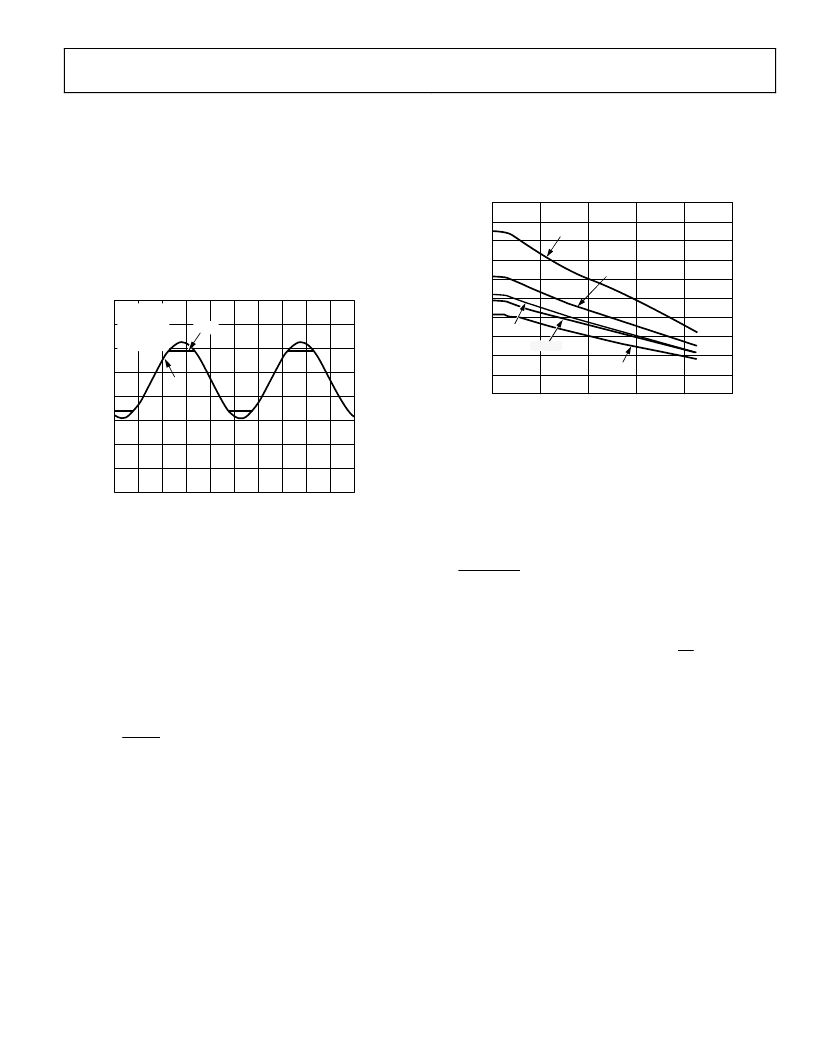- 您現(xiàn)在的位置:買賣IC網(wǎng) > PDF目錄373951 > AD8608AR (ANALOG DEVICES INC) Precision Low noise CMOS Rail-to-Rail Input/Output Operational Amplifiers PDF資料下載
參數(shù)資料
| 型號(hào): | AD8608AR |
| 廠商: | ANALOG DEVICES INC |
| 元件分類: | 運(yùn)動(dòng)控制電子 |
| 英文描述: | Precision Low noise CMOS Rail-to-Rail Input/Output Operational Amplifiers |
| 中文描述: | QUAD OP-AMP, 750 uV OFFSET-MAX, 10 MHz BAND WIDTH, PDSO14 |
| 封裝: | MS-012AB, SOIC-14 |
| 文件頁(yè)數(shù): | 13/20頁(yè) |
| 文件大小: | 559K |
| 代理商: | AD8608AR |
第1頁(yè)第2頁(yè)第3頁(yè)第4頁(yè)第5頁(yè)第6頁(yè)第7頁(yè)第8頁(yè)第9頁(yè)第10頁(yè)第11頁(yè)第12頁(yè)當(dāng)前第13頁(yè)第14頁(yè)第15頁(yè)第16頁(yè)第17頁(yè)第18頁(yè)第19頁(yè)第20頁(yè)

AD8605/AD8606/AD8608
APPLICATION INFORMATION
Rev. D | Page 13 of 20
OUTPUT PHASE REVERSAL
Phase reversal is defined as a change in polarity at the output of
the amplifier when a voltage that exceeds the maximum input
common-mode voltage drives the input.
Phase reversal can cause permanent damage to the amplifier; it
may also cause system lockups in feedback loops. The AD8605
does not exhibit phase reversal even for inputs exceeding the
supply voltage by more than 2 V.
TIME (4
μ
s/DIV)
V
V
OUT
V
IN
V
S
= ±2.5V
V
IN
= 5V p-p
A
V
= 1
R
L
= 10k
0
Figure 43. No Phase Reversal
MAXIMUM POWER DISSIPATION
Power dissipated in an IC causes the die temperature to
increase. This can affect the behavior of the IC and the
application circuit performance.
The absolute maximum junction temperature of the AD8605/
AD8606/AD8608 is 150°C. Exceeding this temperature could
cause damage or destruction of the device. The maximum
power dissipation of the amplifier is calculated according to
the following formula:
JA
A
J
DISS
P
T
T
θ
=
where:
T
J
= junction temperature
T
A
= ambient temperature
θ
JA
= junction to-ambient-thermal resistance
Figure 44 compares the maximum power dissipation with
temperature for the various AD8605 family packages.
TEMPERATURE (°C)
1.0
0.8
0
0
100
20
P
40
60
80
0.6
0.4
0.2
SOIC-14
2.0
1.8
1.6
1.4
1.2
SOIC-8
SOT-23
MSOP
0
TSSOP
Figure 44. Maximum Power Dissipation vs. Temperature
INPUT OVERVOLTAGE PROTECTION
The AD8605 has internal protective circuitry. However, if the
voltage applied at either input exceeds the supplies by more
than 2.5 V, external resistors should be placed in series with the
inputs. The resistor values can be determined by the formula
(
)
(
)
R
S
200
mA
5
V
V
S
IN
+
≤
The remarkable low input offset current of the AD8605 (<1 pA)
allows the use of larger value resistors. With a 10 k resistor at
the input, the output voltage has less than 10 nV of error
voltage. A 10 k resistor has less than 13 nV/√Hz of thermal
noise at room temperature.
THD + NOISE
Total harmonic distortion is the ratio of the input signal in V
rms to the total harmonics in V rms throughout the spectrum.
Harmonic distortion adds errors to precision measurements
and adds unpleasant sonic artifacts to audio systems.
The AD8605 has a low total harmonic distortion. Figure 45
shows that the AD8605 has less than 0.005% or
86 dB of THD
+ N over the entire audio frequency range. The AD8605 is
configured in positive unity gain, which is the worst case, and
with a load of 10 k.
相關(guān)PDF資料 |
PDF描述 |
|---|---|
| AD8608ARU | Precision Low noise CMOS Rail-to-Rail Input/Output Operational Amplifiers |
| AD8605ART-REEL | Precision Low noise CMOS Rail-to-Rail Input/Output Operational Amplifiers |
| AD8605ART-REEL7 | Precision Low noise CMOS Rail-to-Rail Input/Output Operational Amplifiers |
| AD8605ARTZ-REEL | Precision Low noise CMOS Rail-to-Rail Input/Output Operational Amplifiers |
| AD8605ARTZ-REEL7 | Precision Low noise CMOS Rail-to-Rail Input/Output Operational Amplifiers |
相關(guān)代理商/技術(shù)參數(shù) |
參數(shù)描述 |
|---|---|
| AD8608ARN | 制造商:未知廠家 制造商全稱:未知廠家 功能描述:Operational Amplifier |
| AD8608AR-REEL | 制造商:Analog Devices 功能描述:OP Amp Quad GP R-R I/O 5.5V 14-Pin SOIC N T/R |
| AD8608AR-REEL7 | 制造商:Analog Devices 功能描述:OP Amp Quad GP R-R I/O 5.5V 14-Pin SOIC N T/R |
| AD8608ARU | 制造商:Analog Devices 功能描述:IC OP-AMP QUAD R/R |
| AD8608ARU-REEL | 制造商:Analog Devices 功能描述:OP Amp Quad GP R-R I/O 5.5V 14-Pin TSSOP T/R |
發(fā)布緊急采購(gòu),3分鐘左右您將得到回復(fù)。